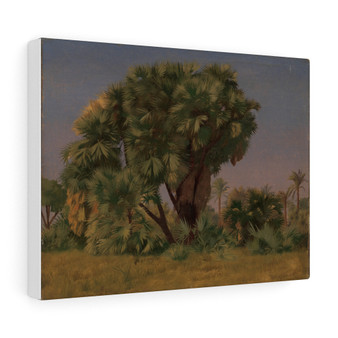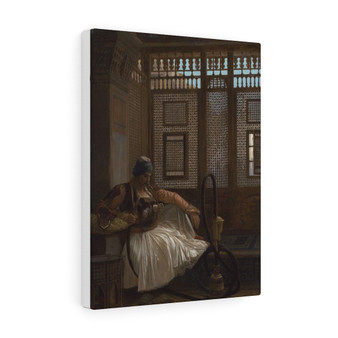Product Description
Bashi-Bazouk 1868–69 Jean-Léon Gérôme French.
Beautiful art by masters in public domain. This arresting picture was made after Gérôme returned to Paris from a twelve-week journey to the Near East in early 1868. He was at the height of his career when he dressed a model in his studio with textiles he had acquired during the expedition. The artist’s Turkish title for this picture—which translates as "headless"—evokes the unpaid irregular soldiers who fought ferociously for plunder under Ottoman leadership, although it is difficult to imagine this man charging into battle wearing such an exquisite silk tunic. Gérôme’s virtuosic treatment of textures provides a sumptuous counterpoint to the figure’s dignified bearing. Inscription: Signed (left margin): J. L. GEROME Title: Bashi-Bazouk Artist: Jean-Léon Gérôme (French, Vesoul 1824–1904 Paris) Date: 1868–69 Medium: Oil on canvas A photograph of the painting is mounted into the "Recueil; oeuvres de Jean-Léon Gérôme," vol. 9, no. 7, as "Bachi-Bouzouk nègre"; Bibliothèque Nationale de France, Paris, inv. no. DC- 293 (A+, 9) -FT4. This is one of twenty-eight albums containing photographs of paintings by Gérôme presented by his widow to the library (see Ackerman 1986). "Winter Exhibition at the French Gallery." Athenæum no. 2246 (November 12, 1870), p. 631, as "A Bachi-Bouzouck". Samuel Putnam Avery Sr. Journal entry. July 21, 1873 [published in Madeleine Fidell Beaufort et al., eds., "The Diaries, 1871–1882, of Samuel P. Avery, Art Dealer," New York, 1979, p. 187], notes that he purchased this work from Wallis for £550. "Opened: The Loan Exhibition for the Bartholdi Pedestal." Brooklyn Daily Eagle (January 10, 1884), p. 2. "Propitious: The First Day of the Bartholdi Loan Exhibition." Brooklyn Daily Eagle (January 11, 1884), p. 2. "The Bartholdi Statue: Brooklyn's Loan Exhibition of Paintings in Aid of the Pedestal Fund." New York Times (January 13, 1884), p. 6. "Brooklyn's Art Collections." The Collector 1 (January 1, 1890), p. 34, discusses Cox's "exceptional specimens" by the artist. "J. L. Gérôme in American Collections." The Collector 1 (September 1, 1890), p. 150, as "A Bashi Bazouk" in the Cox collection. Fanny Field Hering. Gérôme: The Life and Works of Jean Léon Gérôme. New York, 1892, p. 211. Lynne Thornton. Les Orientalistes: Peintres voyageurs, 1828–1908. Paris, 1983, p. 120, ill. (color) [English ed., 1983]. Gerald M. Ackerman. The Life and Work of Jean-Léon Gérôme, with a catalogue raisonné. London, 1986, p. 226, no. 193, ill. pp. 79 and 227 (color and bw), calls it "Black Bashi-Bazouk" and "Bachi-Bouzouk nègre," dates it 1869, and states that it is an anonymous loan to the Museum of Fine Arts, Boston. 19th Century European Paintings, Drawings and Sculpture. Sotheby's, New York. October 27, 1988, unpaginated, under no. 55, states that the painting is on loan to the National Gallery of Art, Washington. Gerald M. Ackerman. Jean-Léon Gérôme: Monographie révisée, catalogue raisonné mis à jour. 2nd rev. ed. [1st ed., 1986]. Paris, 2000, p. 272, no. 193, ill. pp. 84, 273 (color and black and white), calls it "Bachi-Bouzouk nègre" and dates it 1869. Stephen R. Edidin in Gérôme & Goupil: Art and Enterprise. Exh. cat., Musée Goupil, Bordeaux. Paris, 2000, pp. 125–26, under no. 79, ill., p. 157 [French ed., 2000]. Gary Tinterow and Asher Ethan Miller in The Wrightsman Pictures. Ed. Everett Fahy. New York, 2005, pp. 390–92, no. 110, ill. (color and black and white), note that "Bashi-bazouk" is the transliteration of a Turkish term meaning "headless"; state that this picture was probably begun by the middle of 1868 and completed by March 1869; reproduce the Goupil & Cie photograph of the picture and state that it was available for purchase until at least April 1904 (1869–70, Galerie Photographique no. 753, Musée Goupil, Bordeaux). Adrienne L. Childs. "The Black Exotic: Tradition and Ethnography in Nineteenth-Century Orientalist Art." PhD diss., University of Maryland, 2005, pp. 101–2, fig. 23. Everett Fahy in Philippe de Montebello and The Metropolitan Museum of Art, 1977–2008. New York, 2009, p. 33. Alan C. Braddock. Thomas Eakins and the Cultures of Modernity. Berkeley, 2009, pp. 53, 62, fig. 15, without providing documentary evidence, identifies the model as a member of the African diaspora who worked in Paris for academic painters. Gary Tinterow in "Recent Acquisitions, A Selection: 2008–2010." Metropolitan Museum of Art Bulletin 68 (Fall 2010), p. 58, ill. (color). Sophie Makariou and Charlotte Maury in The Spectacular Art of Jean-Léon Gérôme (1824–1904). Ed. Laurence des Cars, Dominique de Font-Réaulx, and Edouard Papet. Exh. cat., J. Paul Getty Museum, Los Angeles. Paris, 2010, p. 260, fig. 122 (color). The Orientalist Sale. Sotheby's, London. April 8, 2014, p. 16 (under no. 6), fig. 1 (color), illustrates it in the the entry for "Bashi-Bazouk" (MMA 2014.435.1). Sidonie Lemeux-Fraitot. L'Orientalisme. Paris, 2015, ill. p. 284 (color). Kathryn Calley Galitz. The Metropolitan Museum of Art: Masterpiece Paintings. New York, 2016, p. 438, no. 359, ill. pp. 368, 438 (color). Zain Abdullah. "The Art of Black Muslim Lives." The Muslim World 110 (July 2020), pp. 274, 281–92, 297, 302–4, figs. 4, 6, 11 (color, overall, framed, and detail on Met guidebook cover), states that the figure carries his weapons much too high; cites his correspondence with Denis A. Sheremetev, a curator of the arsenal of the Russian Museum of Ethnography, St. Petersburg, who identifies the gun depicted as atypical of Istanbul due to its round, rather than octagonal, cross-section and short fore end; states that the portrait was "invented" in the artist's studio after his return to Paris and that it is not a portrait of a particular person encountered on travels in the Muslim world; highlights the image's duality of sensuality and violence; suggests that it might have been the "Bashi-Bazouk" owned by Vanderbilt (probably Ackerman 186). Sebastian Smee. "A Masterpiece with a Complicated Afterlife." Washington Post (December 30, 2020), ill. (color) [https://www.washingtonpost.com/graphics/2020/entertainment/jean-leon-gerome-bashi-bazouk/], states that the artist painted this work in Paris, dressing a local model in garments he acquired in Egypt; notes, in this context, that the Batignolles and Opéra districts in Paris were home to formerly enslaved people and people of color with roots in Africa and the Caribbean, some of whom modeled for Gérôme; muses that with the model's "powerful sense of interiority . . . he belongs in a novel"; discusses the painting's provenance. Designed for indoor use, custom stretched canvas prints are made from treated cotton - providing the smoothest of matte surfaces for exceptional design vividity. A combination of quality and durability, these hangings come with a lifelong color guarantee; there's significant confidence in their withstanding the test of time. On the backside, pre-installed hanging hardware ensures proper locking to walls.
.: 100% cotton fabric
.: Wooden frame
.: High image quality and detail
.: For indoor use
#styleathome #homedecor #paintingsforhome #classicalart


























